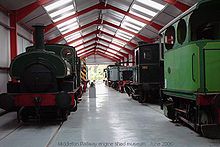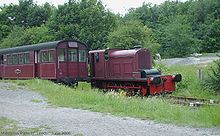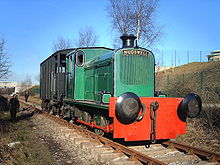- Middleton Railway
-
Middleton Railway 
The Collier, aquatint by Robert Havell 1814, showing a Matthew Murray steam locomotive (Salamanca) on the Middleton Railway Commercial operations Original gauge until 1881 4 ft 1 in (1,245 mm)
from 1881 4 ft 8 1⁄2 in (1,435 mm)Preserved operations Preserved gauge 4 ft 8 1⁄2 in (1,435 mm) Commercial history Preservation history The Middleton Railway is the world's oldest continuously working railway. It was founded in 1758 and is now a heritage railway run by volunteers from The Middleton Railway Trust Ltd. since 1960.
The railway operates passenger services at weekends and on public holidays over approximately 1 mile (1.6 km) of track between its headquarters at Moor Road, Hunslet, Leeds, West Yorkshire, England and Park Halt on the outskirts of Middleton Park.
Contents
Origins
Coal has been worked in Middleton since the 13th century, from bell pits, gin pits and later "day level" or adits. Anne Leigh, heiress to the Middleton Estates, married Ralph Brandling from Felling near Gateshead on the River Tyne. They lived in Gosforth and left running of the Middleton pits to agents. Charles Brandling was their successor. In 1754, Richard Humble, from Tyneside, was his agent. Brandling was in competition with the Fentons in Rothwell who were able to transport coal into Leeds by river, putting the Middleton pits at considerable disadvantage. Humble's solution was to build waggonways which were common in his native north east. The first waggonway in 1755 crossed Brandling land and that of friendly neighbours to riverside staithes.[1]
In 1757 he began to build a waggonway towards Leeds, and to ensure its permanence Brandling sought ratification in an Act of Parliament, (31 Geo.2, c.xxii, 9 June 1758) the first authorising the building of a railway.
An ACT for Establishing Agreement made between Charles Brandling, Esquire, and other Persons, Proprietors of Lands, for laying down a Waggon-Way in order for the better supplying the Town and Neighbourhood of Leeds in the County of York, with Coals.The Middleton Railway, the first railway to be granted powers by Act of Parliament, carried coal cheaply from the Middleton pits to Casson Close, Leeds (near Meadow Lane, close to the River Aire). Not all the land belonged to Brandling, and the Act gave him power to obtain wayleave. Otherwise the line was privately financed and operated, initially as a waggonway using horse-drawn vehicles called corves. Around 1807 the wooden tracks began to be replaced with superior iron edge rails to a gauge of 4 ft 1 in (1,245 mm).
Introduction of steam
In 1812 the Middleton Steam Railway became the first commercial railway to successfully use steam locomotives. John Blenkinsop, the colliery's viewer, or manager, had decided that an engine light enough not to break the cast iron track would not have sufficient adhesion, bearing in mind the heavy load of coal wagons and the steep track gradient. Accordingly he relaid the track on one side with a toothed rail, which he patented in 1811 (the first rack railway), and approached Matthew Murray of Fenton, Murray and Wood, in Holbeck, to design a locomotive with a pinion which would mesh with it. Murray's design was based on Richard Trevithick's Catch me who can, adapted to use Blenkinsop's rack and pinion system, and was called Salamanca. This 1812 locomotive was the first to use two cylinders. These drove the pinions through cranks which were at right angles, so that the engine would start wherever it came to rest.
Though it was considered a marvel at the time, a child who witnessed it was less impressed. The child, David Joy, became a successful engineer.
Living in Hunslet Lane, on the London Road, the old coal railway from the Middleton Pits into Leeds, ran behind our house a few fields off, and we used to see the steam from the engines rise above the trees. Once I remember going with my nurse, who held my hand (I had to stretch it up to hers, I was so little) while we stood to watch the engine with its train of coal-wagons pass. We were told it would come up like a flash of lightning, but it only came lumbering on like a cart. [2]
In 1812, Salamanca was the first commercial steam locomotive to operate successfully, and along with three other locomotives built for the Middleton colliery, remained in use for twenty years. In 1881 the railway was converted to 4 ft 8 1⁄2 in (1,435 mm) standard gauge.
Preservation
In June 1960, the Middleton Steam Railway became the first standard-gauge railway to be taken over and operated by unpaid volunteers. Passenger services were initially operated for only one week, using an ex Swansea and Mumbles Railway double deck tram (the largest in Britain seating 106 passengers). However, the volunteers of the Middleton Railway operated a freight service until 1983.
Regular operation of passenger services began in 1969.
The Middleton Steam Railway is home to a representative selection of locomotives built in the Jack Lane, Hunslet area by the famous Leeds manufacturers of John Fowler & Co., Hudswell Clarke, Hunslet Engine Company, Kitson & Co. and Manning Wardle. The locomotives include "Sir Berkeley", which was featured in the 1968 BBC TV version of "The Railway Children". The locomotive is owned by the Vintage Carriages Trust of Ingrow near Keighley.
Route and Stations
- Park Halt - Terminus
Located close to the site of an old colliery.
- Moor Road - Current Terminus
Located few metres nr Level crossing and road.
- Hunslet - Proposed
Proposed in hope of interchanging with the national network.
Motive Power
Steam Locomotives
Operational
- Manning Wardle L Class 0-6-0ST no. 1210 Sir Berkeley. Recently returned to traffic after a boiler replacement but now used on passenger trains at Middleton, boiler ticket expires in 2017. In May 2008 the locomotive visited the National Railway Museum in York and hauled two bogie passenger coaches over the Spring Bank Holiday Weekend. This locomotive is on loan from the Vintage Carriages Trust, at Ingrow Railway Centre, on the Keighley and Worth Valley Railway.[4]
- Hudswell Clarke 0-6-0T M.S.C. 67 (works number 1369 of 1921). Returned to traffic in 2002, after its pistons were re-bored. The boiler inspection ticket (Certification) expires in 2012.[5]
- Manning Wardle No. 1601 "Mathew Murray". Returned To Service In June 2010. Boiler Ticket Expires In 2020
- NER LNER Class Y7 0-4-0T No. 1310. Returned to traffic in October 2011. Boiler Ticket expires in 2021
Undergoing light work
Undergoing Overhaul/Restoration
[6]Hunslet 0-4-0ST No 1493. Undergoing restoration to operational condition, the frames have their wheels and are being painted before the motion goes on.
- Hawthorn Leslie 0-4-0ST No 6 "Swanscombe". Undergoing restoration to working order, the frames have been re-wheeled and painted and the cab has been fitted to the frames and is being painted, the final motion parts are being fitted and work on the saddle tank, smokebox and boiler will start afterwards.
- Manning Wardle 0-4-0ST No. 14. In the final stages of overhaul, wheels fitted under the frames and boiler being retubed.
Stored
- Bagnall 0-4-0ST No. 2702. Stored outside in the elements.
- Borrows 0-4-0WT No. 53 Windle. Currently being given a protective coat of paint. Planned to be overhauled in the not too distant future.
- Peckett and Sons 0-4-0ST No. 2003 John Blenkinsop. Stored awaiting overhaul but should be one of the next to be returned to working order.
- Sentinel 4wVBT No. 68153. Stored dismantled in the yard.[7]
- Hudswell Clarke 0-4-0ST No. 1309.[8]
- Chemnitz 0-4-0WT 385, ex DSB.[9]
- Hudswell Clarke 0-4-0ST No. 1882 Mirvale.[10]
- Cockerill 0-4-0VBT 1625.[11]
- Peckett and Sons 0-4-0ST No. 2103.[12]
- Kitson 0-6-0ST 5469 ex Northamptonshire Ironstone Railway.
- Hunslet Engine Company 0-6-0ST 2387 Brookes No.1. Out of traffic, boiler ticket expired in 2009.[13]
Diesel Locomotives
Operational
- Hudswell Clarke 0-4-0DM 577 Mary[14]
- Hudswell Clarke 0-4-0DM 631 Carroll[15]
- Brush/Beyer Peacock 0-4-0DE 91[16]
- Thomas Hill 0-4-0DH 138C[17]
- 5003 Peckett 0-4-0DM Austins No. 1[18]
- Hunslet 0-6-0DM 1697 John Alcock[19]
- Hunslet 0-4-0DM 1786 Courage[20]
Non-Operational[21]
- Hunslet 4wDH Rack BEM402 (works number 8505) on loan from the National Coal Mining Museum for England (3 ft (914 mm) narrow gauge)
- Hunslet 6273 on loan from the National Coal Mining Museum for England. (2 ft 2 in (660 mm) gauge)
- J. Fowler 0-4-0DM 3900002[22]
Non-Operational Electric Locomotives
- 420452 Greenwood and Batley Coke Oven locomotive built 1979[23]
Operational Diesel Inspection Vehicle
- DB998901 Drewry car[24]
References
- Notes
- ^ History of the Middleton Railway Leeds Sixth Edition (1990), p.3.
- ^ Diaries of the Late David Joy; edited G.A. Sekon.. Railway Magazine 1908 Volumes 22 & 23
- ^ Middleton Railway - Locomotives
- ^ Rollingstock
- ^ Rollingstock
- ^ [1]
- ^ [2]
- ^ [3]
- ^ [4]
- ^ [5]
- ^ [6]
- ^ [7]
- ^ Rollingstock
- ^ [8]
- ^ [9]
- ^ [10]
- ^ [11]
- ^ [12]
- ^ [13]
- ^ [14]
- ^ Industrial Railway Society (2009), Industrial Locomotives (15EL), Industrial Railway Society, ISBN 978 1 901556 53 7
- ^ Diesel
- ^ [15]
- ^ [16]
- Bibliography
- A History of the Middleton Railway Leeds Sixth Edition, Middleton Railway Trust Limited, 1990
- Ransom, P.J.G. (1990), The Victorian Railway and How It Evolved, Heinemann:London
External links
- The Middleton Railway
- Leodis photographic archive (search keyword: Middleton Railway)
- South Leeds Industrial Heritage Trail
- "The Collier" (Middleton Railway Scene 1814 or earlier)
- Map sources for Middleton Railway
Categories:- Heritage railways in England
- Visitor attractions in Leeds
- Early British railway companies
- 4ft gauge railways
- Narrow gauge railways in England
- Transport in Leeds
- Leeds
- Rail transport in West Yorkshire
- Railway lines opened in 1758
- Rack railways
- Rack railways in the United Kingdom
- Museums in West Yorkshire
- Railway museums in England
- Standard gauge railways in England
- Horse-drawn railways
Wikimedia Foundation. 2010.




